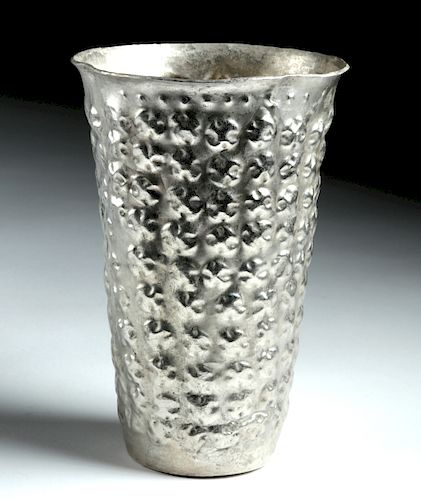Sican Silver Kero with Star Motifs
Lot 131e
About Seller
Artemis Gallery
686 S Taylor Ave, Ste 106
Louisville, CO 80027
United States
Selling antiquities, ancient and ethnographic art online since 1993, Artemis Gallery specializes in Classical Antiquities (Egyptian, Greek, Roman, Near Eastern), Asian, Pre-Columbian, African / Tribal / Oceanographic art. Our extensive inventory includes pottery, stone, metal, wood, glass and textil...Read more
Estimate:
$2,000 - $3,000
Absentee vs Live bid
Two ways to bid:
- Leave a max absentee bid and the platform will bid on your behalf up to your maximum bid during the live auction.
- Bid live during the auction and your bids will be submitted real-time to the auctioneer.
Bid Increments
| Price | Bid Increment |
|---|---|
| $0 | $25 |
| $300 | $50 |
| $1,000 | $100 |
| $2,000 | $250 |
| $5,000 | $500 |
| $10,000 | $1,000 |
| $20,000 | $2,500 |
| $50,000 | $5,000 |
| $100,000 | $10,000 |
| $200,000 | $20,000 |
About Auction
By Artemis Gallery
Feb 21, 2019
Set Reminder
2019-02-21 10:00:00
2019-02-21 10:00:00
America/New_York
Bidsquare
Bidsquare : Exceptional Antiquities, Asian, Ethnographic
https://www.bidsquare.com/auctions/artemis-gallery/exceptional-antiquities-asian-ethnographic-3858
An important one-day auction featuring museum-worthy examples of Egyptian, Greek, Roman, Etruscan, Near Eastern, Far East / Asian, Pre-Columbian, African / Tribal, Oceanic, Native American, Spanish Colonial, Russian, Fossils, Ancient Jewelry, Fine Art, so much more! Artemis Gallery info@artemisgallery.com
An important one-day auction featuring museum-worthy examples of Egyptian, Greek, Roman, Etruscan, Near Eastern, Far East / Asian, Pre-Columbian, African / Tribal, Oceanic, Native American, Spanish Colonial, Russian, Fossils, Ancient Jewelry, Fine Art, so much more! Artemis Gallery info@artemisgallery.com
- Lot Description
Pre-Columbian, North Coast Peru, Sican-Lambayeque, ca. 800 to 1000 CE. A silver (60% silver) kero or drinking cup decorated from top to bottom with a repeated rows of repousse star motifs. The indigenous of Peru created these vessels for more than domestic purposes. Rather they were used during life and after life at funerary ceremonies that incorporated intricate religious libations and imbibing rites. Size: 4.375" in diameter across the mouth x 6.875" H (11.1 cm x 17.5 cm); Precious metal content: 60% silver.
To create this piece, the ancient metalsmith hammered a silver piece into a very thin sheet, approximately the size of the finished work. Then the artisan used fine-grained stone anvils and hammer stones made of hematite or green porphyry, sometimes with animal hide attached, and a wooden template was used to create the form and its repoussé ornamentation, as the metalsmith hammered the silver sheet upon the wooden template.
Silver and other metal vessels were made at Cerro Huaringa, in vast smelting furnaces and workshops. People used these keros to drink chicha, a fermented drink crucial to religious and burial rites as well as ritual celebrations around planting and harvest time. Chica was made from maize, quinoa, or squash, with a local alcohol content and fermented through the use of saliva - women chewed the food and then boiled it in water, leaving the enzymes from their mouths to produce the malt for fermentation.
Provenance: private Hawaii, USA collection; ex-private Hans Juergen Westermann collection, Germany
All items legal to buy/sell under U.S. Statute covering cultural patrimony Code 2600, CHAPTER 14, and are guaranteed to be as described or your money back.
A Certificate of Authenticity will accompany all winning bids.
We ship worldwide and handle all shipping in-house for your convenience.
#144356Four small cracks. Normal surface wear and indentations commensurate with age. Silver has developed a nice age patina.Condition
- Shipping Info
-
All shipping is handled in-house for your convenience. Your invoice from Artemis Gallery will include shipping calculation instructions. If in doubt, please inquire BEFORE bidding for estimated shipping costs for individual items.
-
- Buyer's Premium



 EUR
EUR CAD
CAD AUD
AUD GBP
GBP MXN
MXN HKD
HKD CNY
CNY MYR
MYR SEK
SEK SGD
SGD CHF
CHF THB
THB













